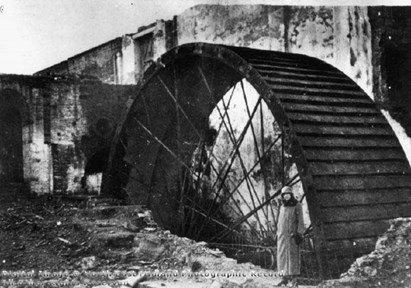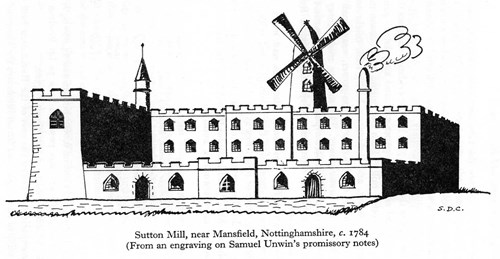The History of Mill Waters
Watch Discover Ashfield with Luddite leader Jeremiah Brandreth
Watch Discover Ashfield with the 4th Duke of Portland, William Bentinck
Mill Waters today is known as a peaceful haven for wildlife and filled with leisure activities, but in the early 19th century the area was a thriving manufacturing hub. There are three public spaces along the River Maun Corridor at Mill Waters, found between Sutton in Ashfield and Mansfield. These are Kings Mill Reservoir, Sutton Lawn, and Hermitage Ponds, where the Industrial Revolution and better transport links significantly changed the area's manufacturing landscape.
The early mills
The area around Kings Mill Reservoir in the 19th century offered a swathe of water powered mills along the River Maun extending towards Mansfield. A record of a mill at King’s Mill can be traced back to the Domesday book published in 1086.
Watch Discover Ashfield with the 4th Duke of Portland, William Bentinck
Mill Waters today is known as a peaceful haven for wildlife and filled with leisure activities, but in the early 19th century the area was a thriving manufacturing hub. There are three public spaces along the River Maun Corridor at Mill Waters, found between Sutton in Ashfield and Mansfield. These are Kings Mill Reservoir, Sutton Lawn, and Hermitage Ponds, where the Industrial Revolution and better transport links significantly changed the area's manufacturing landscape.
The early mills
The area around Kings Mill Reservoir in the 19th century offered a swathe of water powered mills along the River Maun extending towards Mansfield. A record of a mill at King’s Mill can be traced back to the Domesday book published in 1086.
 In those days Sutton and Skegby were part of Mansfield, and King’s Mill was used to grind corn to make flour powered by the water from a small pond. There are references to other mills in the area, including Hermitage Mill in 1302, and Stanton Mill, then known as Walke Mill, in 1370.
In those days Sutton and Skegby were part of Mansfield, and King’s Mill was used to grind corn to make flour powered by the water from a small pond. There are references to other mills in the area, including Hermitage Mill in 1302, and Stanton Mill, then known as Walke Mill, in 1370.The Industrial Revolution and the Luddites
Until the Industrial Revolution people had spun wool or knitted on machines, or frames, in their homes. With the advent of new technology, which increased the speed of production, small workshops began to spring up and the framework knitters’ profits plummeted.
Their cause was taken up by the Luddite movement, which organised protests and the smashing up of frames. One of the Luddite leaders, Jeremiah Brandreth, lived in Sutton and died for the cause.
The invention of the Water Frame spinning machine by Richard Arkwright in 1769, which could spin 96 strands of yarn at once, signalled the birth of factory production. It was Samuel Unwin who brought the technology to Sutton, and created his first factory on what is now Sutton Lawn. Between the 1780s and late 1830s, many more mills along the River Maun were either built or converted, mainly for cotton doubling - a process for twisting threads together to create a yarn.
The creation of the reservoir
The land around the Mill Waters Heritage Site was part of the 15,000 acre Welbeck Estate, owned by the Dukes of Portland from 1734 until it became a limited company in 1923. There wasn’t a reservoir until 1839. The family still own the business, although there is no longer a Duke. William Bentinck, the 4th Duke of Portland, commissioned the flooding of the 72 acres of farmland in 1837, including the ancient mill pond near the old King’s Mill, to create a reservoir that would supply water all year round to the mills further down the River Maun, so that they could stay competitive.
The reservoir took two years to dig out. Many men had returned from the Napoleonic Wars and the project gave work to them, as well as the unemployed stockingers in the town. According to the historian Albert Sorby Buxton, the labourers were helped by donkeys who were used to trample down the banks. The 4th Duke was known affectionately as ‘Old Leather Breeches’ by his tenants, and 800 of them clubbed together to commission his 80th birthday portrait wearing his signature clothing in 1852.
Portland Viaduct
Until the railways were invented in the early 1800s, goods from Sutton were transported by waggons pulled by horses or mules along roads. The creation of the Cromford to Nottingham canal opened up new markets for Sutton's industrialists in Nottingham, Derby, and Leicester - the nearest wharf for loading being at Pinxton.
By the early 1800s, local businessmen began to discuss plans for a railway from Mansfield to Pinxton, which would enable them to transport produce at a lower cost by connecting directly to the canal. This would remove the need for road waggons and pack horses. In 1817, an Act of Parliament gave the proposal the green light. The estimated cost of the railway was £22,300 - almost £2 million in today’s money.
 Portland Viaduct is an important feature of the original line, found at the west end of Hermitage Ponds. The viaduct became redundant in 1871 when the line was straightened. The structure is Grade II listed by Historic England, which means it is protected by law.
Portland Viaduct is an important feature of the original line, found at the west end of Hermitage Ponds. The viaduct became redundant in 1871 when the line was straightened. The structure is Grade II listed by Historic England, which means it is protected by law. Construction of the Mansfield end of the railway was overseen by James Heygate, the owner of Hermitage Mill. He was rewarded for his service with a single railroad from the railway, 112 yards in length, directly to the engine house of his mill.
How the Unwin family spun a reputation for Sutton's textiles
Long before the success of brands like Pretty Polly and Aristoc in Sutton in Ashfield, the Unwin family had made a name for themselves as pioneers of textile manufacturing. Samuel Unwin was a Londoner who moved to Sutton, and became wealthy as a farmer and textiles merchant. Samuel had two sons, William and Samuel junior, who both married heiresses.
 In 1740, Samuel built a mill on East Side, at the bottom end of Sutton Lawn, next to the dam. The mill was built for cotton spinning and powered by horse capstan.
In 1740, Samuel built a mill on East Side, at the bottom end of Sutton Lawn, next to the dam. The mill was built for cotton spinning and powered by horse capstan.In 1770, Samuel’s son William upgraded the mill into an impressive four-storey castellated factory incorporating Richard Arkwright’s newly patented water frame, which was powered by a 24-foot wheel supplied by Sutton Lawn's dam and fed by the River Idle. The factory created many jobs and young apprentices were drafted in from London and other parts of the country. Remnants of the original mills have been retained in the modern residential buildings.
Samuel died in June 1774 and his son William died suddenly just a month afterwards leaving the family business in the hands of 30-year-old Samuel junior. Samuel the younger grew the business and earned a reputation for the excellence of his fabrics, principally nankeen and gingham. The historian S D Chapman said: "Unwin’s wealth was a byword. Local people said that each time his great wheel turned it put a guinea in his pocket."
Places to visit
Enjoy an interactive learning experience about the history of the mills, the Unwin family, and the social unrest which followed the Industrial Revolution by visiting the Heritage Centre at Mill Waters. Learn about what you can do when visiting Sutton Lawn and Kings Mill Reservoir.